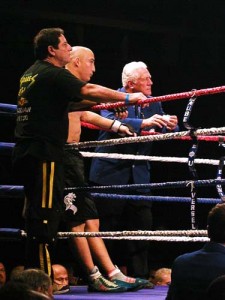I trained with Denis Kang for the first five or six years of his MMA career. At some point during that time he became very, very difficult to sweep. Partially this was due to his increasing technical knowledge, but it was also more than that.
 Denis (getting ready to fight in the picture to the right) started refusing to accept getting swept, and would keep on scrambling and fighting the sweep from its initiation to its very end. Even when I managed to complete the first 90% of a sweep on him I could usually never finish the last 10%: at the very last instant he would bounce, twitch, roll and scramble, ending up back on his feet again.
Denis (getting ready to fight in the picture to the right) started refusing to accept getting swept, and would keep on scrambling and fighting the sweep from its initiation to its very end. Even when I managed to complete the first 90% of a sweep on him I could usually never finish the last 10%: at the very last instant he would bounce, twitch, roll and scramble, ending up back on his feet again.
Needless to say, this was VERY frustrating.
Refusing to concede a sweep has a lot of advantages. In MMA the bottom position is almost always a bad place to be, because your opponent can use gravity and land some very heavy blows. In BJJ and submission wrestling getting swept costs you points which could lose you the match.
Some grapplers, however, give up too easily when fighting a sweep. Often this is particularly noticeable for grapplers who love the guard position: they are almost relieved to be swept because it means that they can retreat to their comfort zone and start working their own guard game. Probably their jiu-jitsu would improve faster if they tried to keep the top position and worked on their guard passing skills.
Some people might argue that high-speed scrambling uses up too much energy, but think of it this way: if you do get swept and pinned then how much energy are you going to have to use to escape to a neutral position? It’s probably a lot better to use some energy up front and prevent the sweep from getting finalized, rather than ending up in a bad position and having to settle in for a long, hard, and defensive fight.
Scrambling out of sweeps can be taught and trained. What you need is a training partner who will sweep you at 50% to 70% of regular speed, and then takes his time finalizing the sweep by coming to the top position rather slowly. He has to give you the time to scramble and get your legs back underneath you, rather than jumping on top of you and squishing you flat. It can be difficult to find someone who is willing to help you this way, but the results of this sort of training can be very valuable.
IMPORTANT CAVEAT: I don’t want to end on a downer, but I have to point out that refusing the concede the sweep is not without its own dangers. If you’re trying to stop a very high-energy sweep, or if your opponent is heavy (or heavier than you), then the consequences of posting an arm out could include a sprained wrist, a hyperextended elbow or even a broken bone in the arm. The basic rule here is that it is OK to scramble but it is NOT OK to post on the ground with a straight arm. Better to concede the sweep than end up with your arm in a cast for six weeks!
Not having your arm straight and posted on the mat was also discussed in this previous tip: www.grapplearts.com/2008/02/simplest-way-to-avoid-injury.htm
Finally, some people take the principle we’re discussing a step further and apply it to their standup wrestling, which is to say that they refuse to concede the takedown even after all their technical counters have failed. This approach is valid and has won a lot of matches, but the danger level of doing this is very high. I know several people who have broken their arms or dislocated their shoulders posting on their hands while fighting a throw, and every decent size Judo tournament features multiple visits from ambulance crews to pick up and cart off yet another Judoka who was doing all sorts of silly things while trying not to get thrown. Do it if you want to, but consider yourself officially warned!
The post Refusing to Concede the Sweep appeared first on Grapplearts.
